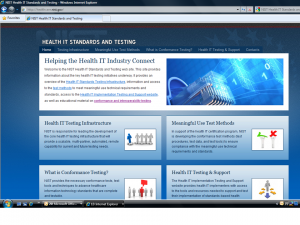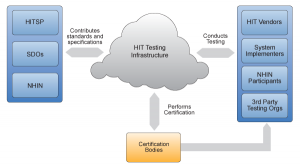Listening Session for Health IT Strategic Framework: April 6, 2010
Preview HIT Strategic Framework: Strategic Themes, Principles, Objectives, and Strategies
Review 2008 Strategic Plan
ONC emailed and posted information March 24, 2010, about the listening session scheduled for April 6, 2010. The plan dated March 23, 2010 is marked as version 30, and a version has been previously shared online and discussed as part of at least one HIT FACA public meeting. Information on session is excerpted from ONC email and Web site.
“The Strategic Plan Workgroup of HIT Policy Committee will hold a public listening session on April 6, 2010, 12pm ET, to obtain feedback on the Health IT Strategic Framework. This Framework will be a key input to the Federal Health IT Strategic Plan.*
”The objective of the listening session is to obtain feedback from the healthcare community regarding the Health IT Strategic Framework which will become foundation for the updates to the Federal Health IT Strategic Plan. The Health IT Strategic Plan will focus on 2011 through 2015 time period as well as lay the ground work for the period beyond 2015 to create a learning health system through the effective use of HIT.”
Draft Framework (pdf) has been posted on ONC Health IT Web site for review.
“Registration for this event will be required in order to accommodate the number of interested parties. Visit http://events.signup4.com/hitstrategic to register to attend the session. Meeting materials will be posted at http://healthit.hhs.gov/StrategicPlanWG as they become available. Thank you for your interest.”
“*The HITECH Act requires the Office of the National Coordinator for Health Information Technology (ONC), in consultation with other appropriate Federal agencies, to update the Federal Health IT Strategic Plan published in June 2008.”
Health IT Strategic Framework: Strategic Themes, Principles, Objectives, and Strategies
PDF version with selected excerpts below.
Strategic Planning Scope
“–The Federal Health IT Strategic Plan Update will encompass three levels:
–The full array of entities in the public and private sectors who have a role in affecting and implementing the use of HIT to improve health and health care;
–The broad array of Federal HIT policies, regulations, systems, and activities; and
–The specific mandate, authorities, and role of the ONC.
–The Update will emphasize the implementation of legislative imperatives to achieve widespread adoption and meaningful use of HIT.
–The Update will also focus on features that would be essential to continue the adoption and value of HIT beyond ARRA funding.
–The Health IT Strategic Plan Update will focus on 2011 through 2015 time period.
–It will also focus on laying the ground work for the period beyond 2015 to create a learning health system through the effective use of HIT.”
VISION AND PREAMBLE
“Vision – A learning health system that is patient-centered and uses information to continuously improve health and health care of individuals and the population.
“A learning health system is a system that is designed to generate and apply the best evidence for the collaborative health care choices of each patient and provider; to drive the process of new discovery as a natural outgrowth of patient care; and to ensure innovation, quality, safety, and value in health care. A learning health system focuses on the needs of individuals and population health and aims to create a health system that is Patient-centered, Safe, Timely, Effective, Efficient, Equitable. An effective learning health system is where individuals can make informed decisions about their health and health care; patients can exercise choices about sharing of their data; decision makers have access to the right information at the right time in a secure environment; the health delivery system is more efficient; and the health care industry continues to improve population health.
“Health Information Technology (HIT) provides a critical infrastructure for an effective learning health system. HIT offers tools that can expand current capabilities to collect and manage data that can help creation of a sustainable system that facilitates getting the right care to people when they need it and then captures the results for improvement in care, and create and share knowledge.
“Despite the important role of HIT to a learning health system, only a small number of health care organizations have implemented a comprehensive EHR. Getting to widespread adoption and use of HIT is one component of a reformed system – necessary, but not sufficient to effect, the broad change needed in our health system.
“Inherent in the vision of a learning health system is a set of values that provide the foundation for public policies at the Federal and state levels aimed at reforming and improving the health system. The HITECH Act specifies this broader set of values and helps to focus Federal health policy regarding information technology in the following areas:
–Improving privacy and security protections for health information;
–Facilitating individual access to his or her health information;
–Improving quality of health care by improving care coordination, reducing medical errors, reducing chronic disease, reducing health disparities, improving population health, and advancing research and education;
–Addressing the needs of children and other vulnerable populations;
–Collecting information for quality reporting, biosurveillance, public health, medical and clinical research, and drug safety; and
–Improving efficiency and reducing the burden on patients and health care professionals.
“The HIT policies and programs of ONC and its Federal partners aspire to achieve this vision and its inherent values, leveraging the programs authorized by the HITECH Act. To achieve this vision, a transformation of our current health care delivery system is required.
“To begin this transformation, the Federal government proposed a set of priorities for meaningful use of HIT which can also be applied broadly to help achieve the vision. They include:
–Improve quality, safety, efficiency and reduce health disparities;
–Engage patients and families in their health care;
–Improve care coordination;
–Improve population and public health; and
–Ensure adequate privacy and security protections for personal health information.
“Implicit in enabling the HITECH Act and addressing the health priorities are a number of roles that only the Federal government can play in promoting the adoption and use of HIT. One key role involves the provision of resources to support the public-good infrastructure (serving public health, biomedical research, quality improvement, and emergency preparedness). The government also has a role to play when information asymmetries hinder the development of a private market. The efforts involving standards, implementation specifications, and certification criteria are a solution to such problems. Government action is also necessary to spur the adoption of HIT and the development of means for health information exchange to assure the critical mass of users necessary to create a self-sustaining system of interoperable HIT. Finally, working to improve the efficiency of public and population health programs is clearly a government responsibility.
“The Health IT Strategic Framework enumerates critical government roles in the pursuit of a health system that uses information to empower individuals and to improve the health of the population.”
Premable to Strategic Framework (Selected sections)
“The proposed Federal HIT strategies are grouped into four Themes:
1) Meaningful Use of Health Information Technology,
2) Policy and Technical Infrastructure,
3) Privacy and Security, and
4) Learning Health System.
“Themes 1, 2 and 3 focus on establishing the foundation and infrastructure to support a learning health system and Theme 4 focuses on leveraging these resources to create a learning system. These themes are interrelated and must work together to achieve the vision set forth in this Framework.
“Theme 1 focusing on Meaningful Use describes steps towards using HIT to improve care and support a learning health system.
“Themes 2 and 3 focus on the infrastructure for HIT.
“Theme 2 focuses on Policy and Technology infrastructure that is necessary to support Meaningful Use as well as the learning health system for broader HIT i.e. not only EHR but also health information exchange, and other HIT components.
“Theme 3 addresses Privacy and Security issues and challenges related to broader HIT as well.
“Finally, Theme 4 focuses on leveraging these resources to create a learning health system.
“Each Theme… includes a goal, guiding principles, objectives and strategies. The ONC strategic plan will include specific tactics and measures for each Theme.”
Referenced Documents
The (2008) ONC-Coordinated Federal Health IT Strategic Plan: 2008-2012 (pdf)
Dated: June 3, 2008
Nationwide Privacy and Security Framework for
Electronic Exchange of Individually Identifiable Health Information (pdf)
Dated: December 15, 2008. Still considered the benchmark document, the framework describes eight principles that “are expected to guide the actions of all health care-related persons and entities that participate in a network for the purpose of electronic exchange of individually identifiable health information. These principles are not intended to apply to individuals with respect to their own individually identifiable health information.”



